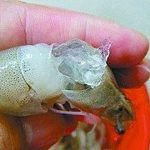“Century” eggs no more? While it doesn’t really take a century to make pidan (more commonly known as century eggs, hundred-year eggs, thousand-year eggs, or millennium eggs,) since the egg-festering process only actually takes about two months, companies in China have found a way to cut the waiting process by half the time.

Unfortunately, this process involves using Industrial Copper Sulphate. Says the South China Morning Post:
“Industrial copper sulphate usually contains high levels of toxic heavy metals, including arsenic, lead and cadmium, so is banned for use as a food additive.”
Operations in thirty companies manufacturing the preserved eggs in Jiangxi Province, China have been halted while investigations are being conducted. Authorities have found that a number of the companies have their business operations licenses in order, prompting speculation that the use of the toxic substance might be a common practice among all manufacturers. According to state-run broadcaster, China Central Television, companies in the area produce about 300,000 tons of century eggs annually or about 15 per cent of the country’s total.
Normally, the putrefaction process, which turns the yolk dark green and gives the egg whites a brownish hue and jelly-like texture, involves using safe-for-consumption ingredients like baking soda, salt, and quicklime. However, a plant boss from one of the companies involved in the scandal was quick to dismiss the danger of using toxic chemicals, telling the South China Morning Post:
“There won’t be a problem if you don’t eat too many of them.”
Photo credit: Egg photo by Alexi Kostibas, as posted on the Smithsonina.com


